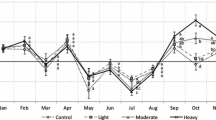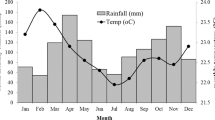Abstract
Tree pruning is a common management practice in agroforestry for mulching and reducing competition between the annual and perennial crop. The below-ground effects of pruning, however, are poorly understood. Therefore, nutrient dynamics and root distribution were assessed in hedgerow plantings of Acacia saligna (Labill.) H.L. Wendl. after tree pruning. Pruning to a height of 1.5 m was carried out in March and September 1996. In July and October 1996, the fine root distribution (< 2 mm) and their carbohydrate contents were determined at three distances to the tree row by soil coring. At the same time, foliar nutrient contents were assessed, whereas nutrient leaching was measured continuously. The highest root length density (RLD) was always found in the topsoil (0–0.15 m) directly under the hedgerow (0–0.25 m distance to trees). Pruning diminished the RLD in the acacia plots at all depths and positions. The relative vertical distribution of total roots did not differ between trees with or without pruning, but live root abundance in the subsoil was comparatively lower when trees were pruned than without pruning. In the dry season, the proportion of dead roots of pruned acacias was higher than of unpruned ones, while the fine roots of unpruned trees contained more glucose than those of pruned trees. Pruning effectively reduced root development and may decrease potential below-ground competition with intercropped plants, but the reduction in subsoil roots also increased the danger of nutrient losses by leaching. Leaching losses of such mobile nutrients as NO3− were likely to occur especially in the alley between pruned hedgerows and tended to be higher after pruning. The reduced size of the root system of pruned acacias negatively affected their P and Mn nutrition. Pruning also reduced the function of the trees as a safety net against the leaching of nutrients for both NO3− and Mn, though not for other studied elements. If nutrient capture is an important aim of an agroforestry system, the concept of alley cropping with pruning should be revised for a more efficient nutrient recycling in the system described here.
Similar content being viewed by others
References
Cannell MGR, van Noordwijk M and Ong CK (1996) The central agroforestry hypothesis: the tree must acquire resources that the crop would not otherwise get. Agrofor Syst 34: 27-31
Droppelmann KJ, Ephrat JE and Berliner PR (2000) Tree/crop complementarity in an arid zone runoff agroforestry system. Agrofor Syst 50: 1-16
Eissenstatt DM and Duncan LW (1992) Root growth and carbohydrate responses in bearing citrus trees following partial canopy removal. Tree Physiology 10: 245-257
Erdmann TK, Nair PKR and Kang BT (1993) Effects of cutting frequency and cutting height on reserves carbohydrates in Gliricidia sepium (Jacq.) Walp. For Ecol Manage 57: 4 5-60
Fownes JH and Anderson D (1991) Changes in nodule and root biomass of Sesbania sesban and Leucaena leucocephala following coppicing. Plant Soil 138: 9-16
Haggar JP and Beer JW (1993) Effect on maize growth of the interaction between increased nitrogen availability and competition with trees in alley-cropping. Agrofor Syst 21: 239-249
Hartemink AE, Buresh RJ, Jama B and Janssen BH (1996) Soil nitrate and water dynamics in sesbania fallow, weed fallows, and maize. Soil Sci Soc Am J 60: 568-574
Heinemann AM, Otieno HJO, Mengich EK and Amadelo BA (1997) Growth and yield of eight agroforestry tree species in line plantings in Western Kenya and their effect on maize yields and soil properties. For Ecol Manage 91: 103-135
Jonsson K, Fidgeland L, Maghembe JA and Högberg P (1988) The vertical distribution of fine roots of five tree species and maize in Morogo, Tanzania. Agrofor Syst 6: 63-69
Kadiata BD, Mulongoy K and Isirimah NO (1998) Effect of tree pruning and pruning application to trees on nitrogen fixation by Leucaena and Gliricidia. Agrofo Syst 39: 117-128
Kandiah S, Wettasinghe DT and Wadasinghe G (1984) Root influence on shoot development in tea (Camellia sinensis (L.) O. Kuntze) following shoot pruning. J Horticult Sc 59: 581-587
Korwar GR and Radder GD (1994) Influence of root pruning and cutting interval of Leucaena hedgerows on performance of alley cropped rabi sorghum. Agrofor Syst 25: 95-109
Lehmann J and Zech W (1998) Fine root turnover of hedgerow intercropping in Northern Kenya. Plant Soil 198: 19-31
Lehmann J, Droppelmann K and Zech W (1998a) Runoff irrigation of crops with contrasting root and shoot development in the semi-arid North of Kenya: water depletion and aboveand below-ground biomass production. J Arid Environm 38: 479-492
Lehmann J, Peter I, Steglich C, Gebauer G, Huwe B and Zech W (1998b) Below-ground interactions in dryland agroforestry. For Ecol Manage 111: 157–169
Lehmann J, Weigl D, Droppelmann K, Huwe B and Zech W (1999) Nutrient cycling in agroforestry with runoff irrigation. Agrofor Syst 43: 49–70
Little TM and Hills FJ (1978) Agricultural Experimentation. Wiley and Sons, New York, USA, 350 pp
Matta-Machado RP and Jordan CF (1995) Nutrient dynamics during the first three years of an alley-cropping agroecosystem in Southern USA. Agrofor Syst 30: 351–362
Mekonnen K, Buresh RJ and Jama B (1997) Root and inorganic nitrogen distribution in sesbania fallow, natural fallow and maize fields. Plant Soil 188: 319–327
Mehlich A (1984) Mehlich 3 soil test extractant: a modification of the Mehlich 2 extractant. Communic Soil Scis Plant Anal 15: 1409–1416
Olsen SR and Sommers LE (1982) Phosphorus. In: Page AL, Miller RH and Keeney DR (eds) Methods of Soil Analysis: Part 2 Chemical and Microbiological Properties. pp 403–430. American Society of Agronomy, Madison, USA
Rao MR, Nair PKR and Ong CK (1998) Biophysical interactions in tropical agroforestry systems. Agrofor Syst 38: 3–50
Sanchez PA (1995) Science in Agroforestry. Agrofor Syst 30: 5–55
Schroth G and Zech W (1995) Root length dynamics in agroforestry with Gliricidia sepium as compared to sole cropping in the semi-decidous rainforest zone of West Africa. Plant Soil 170: 297–306
Schroth G (1995) Tree root characteristics as criteria for species selection and systems design in agroforestry. Agrofor Syst 30: 125–143
Singer MJ and Munns DN (1996) Soils - An Introduction. Prentice Hall, Upper Saddle River, USA, 480 pp
Singh RP, Ong CK and Sahara N (1989) Above and below ground interactions in alley-cropping in semi arid India. Agrofor Syst 9: 259–274
Sposito G (1989) The Chemistry of Soils. Oxford Univ Press, New York, 277pp
Tennant D (1975) A test of modified line intersect method of estimating root length. J Ecol 63: 995–1001
Toky OP and Bisht RP (1992) Observation on the rooting patterns of some agroforestry trees in an arid region of north-west India. Agrofor Syst 18: 245–263
Van Noordwijk M and de Willigen P (1991) Root functions in agricultural Systems. In: Mc Michael BL and Persson H (eds) Plant Roots and Their Enviroments, pp 324–332. Elsevier, pAmsterdam, The Netherlands
Van Noordwijk M, Hairiah K, Syekhfani MS and Flach EN (1991) Peltophorum pterocarpa (Dc.) back (Caesalpiniaceae), a tree with a root distribution for alley cropping on acid soils in the humid tropics. In: Mc Michael BL and Persson H (eds.) Plant Roots and Their Enviroments, pp 526–532. Elsevier, Amsterdam, The Netherlands
Van Noordwijk M and Purnomosidhi P (1995) Root architecture in relation to tree-soil-crop interactions and shoot pruning in agroforestry. Agrofor Syst 30: 161–173
Author information
Authors and Affiliations
Corresponding author
Rights and permissions
About this article
Cite this article
Peter, I., Lehmann, J. Pruning effects on root distribution and nutrient dynamics in an acacia hedgerow planting in northern Kenya. Agroforestry Systems 50, 59–75 (2000). https://doi.org/10.1023/A:1006498709454
Issue Date:
DOI: https://doi.org/10.1023/A:1006498709454




